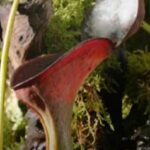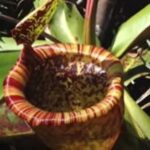As an Amazon Associate, this site earns commissions from qualifying purchases. For more details, click here.
Pitcher plants have a reputation for eating almost any type of small insect. And in case you are wondering, this includes ants. But is it a good idea to let your nepenthes or sarracenia eat these insects? Or is there any sort of danger associated with it? We decided to research this and you will find the essential information here.
The rims of pitcher plants are covered with nectar moisture, and its sugary scent is what attracts ants. The slippery surface causes ants to fall into the pitcher, which is filled with digestive fluids.
How Many Ants Can Pitcher Plants Eat?
Pitcher plants only need to eat one to two bugs a month to satisfy its need for nutrients. You can feed the plant once a week to speed up growth, but 1-2 times a month will not hurt it.
If pitcher plants only eat 1-4 times a month, what happens to other bugs that fall into its traps? It is possible for several bugs to get caught at the same time, especially ants.
In that case the insects will just remain there in the pitcher. Nepenthes will only eat when needed to conserve energy, so if you look into a pitcher and see a few ants, it means the nutritional requirements have been met already.
Pitcher plants that grow in the wild usually eat more bugs than those nurtured indoors. This is because indoor nepenthes are often fed other food such as TetraCichlid Crisps or mealworms. If your pitcher plant is being served nutritious food, it no longer has to eat a lot of ants. The plant might consume a few insects, but not as many if it were not fed regularly.
When a pitcher plant needs more nutrients it will digest the remaining ants in the trap. This assumes the ants have not decayed. You should remove any rotting bugs immediately to avoid the stench and possible plant diseases.
Can You Overfeed Pitcher Plants?
It can be tempting to fill a pitcher with several ants or a mixture of assorted bugs. However that is going to cause more harm than good.
Insects provide important nutrients for carnivorous plants. But there is a reason nepenthes have limited digestive capabilities.
Eating ants is a complex process that requires a lot of resources. Every time a pitcher plant eats, it has to allocate energy to the activity.
If you over feed a pitcher plant, more energy will get out compared to what gets in. The resources required to eat is greater than the energy going in. This is detrimental to the plant which is why it should be avoided.
If your pitcher plant is indoors it is easy to control its food intake. If outdoors, no worries as the plant will not eat more than it can handle. The point is you should not give pitcher plants too much food because chances are, they are already getting enough nourishment.
How Do Pitcher Plants Attract Ants?
Carnivorous plants use visual and other sensory lures to attract ants and other bugs. With ants, the sweet sugary taste of nectar is the most effective bait.
Nepenthes pitcher plants produce nectar, and its moisture spreads to the rim (peristome) and the inner walls of its pitchers. Now imagine an ant nearby smells the nectar and hops onto the pitcher, not knowing it is a trap. The bug drops on the slippery edge and into the cupped pitcher.
The pitcher contains liquids that prevent insects from getting out. An ant will perish either from exhaustion trying to escape, drowning in the liquid or get dissolved by the digestive fluids.
The fluids in the pitchers of some species are home to bacteria, which dissolves fallen prey. Others have insect larvae which feed on bugs caught in the trap. The plant absorbs the excretions of these larvae and turns them into amino acids and other useful elements.
Some species like the Nepenthes gracilis use raindrops to catch insects. Researchers have discovered the lid on its pitcher vibrates when struck by water. When raindrops fall onto the lid, its vibration is so strong it sends the insects down into the trap.
Sarracenia pitcher plants use similar methods as nepenthes. In addition the pitchers have filaments that prevent bugs from getting out. These traps are also too tight for flying insects to spread their wings. Even if they do, the plant generates a vacuum-like effect to prevent their escape.
Nectar is what draws ants, but pitcher plants have lures for other bugs. Some insects are drawn by colorful, uniquely shaped pitchers. All the unique colors and shapes of pitcher plants have the same purpose, to draw prey.
Why Pitcher Plants Eat Ants
So far we have seen the different methods pitcher plants use to trap ants and other bugs. But why? Why do they need to eat these insects?
Pitcher plants need nitrogen, an element usually found in rich soil. However, carnivorous plants only grow in poor soil so they have to find another source. Ants, flies and other bugs contain all the elements needed by these plants which are missing from the ground.
Pitcher plants can only absorb these nutrients from insects. If you plant nepenthes in rich soil it will probably die. If you are propagating pitcher plants, use only nutrient-free media like Rio Hamza Trading Sphagnum Moss.
Pitcher plants require nitrogen to perform various functions such photosynthesis. While they eat bugs, it is considered more of a supplement than food. Plant food is glucose, a simple sugar-like substance produced during photosynthesis.
Ants, flies and other bugs provide the nutrients which are lacking in the soil. With nitrogen, phosphorus and other elements, pitcher plants will grow healthy and strong.
Can You Feed Dead Ants to Pitcher Plants?
Pitcher plants will eat live and dead ants, or any insects for that matter. As long as it can fit in the trap, it is a potential prey.
Healthy pitcher plants have vibrant, liquid filled pitchers. If the pitchers are turning brown there is a problem you need to fix immediately. Aside from the color, you can just take a look inside the pitcher to see how well it is eating. There should always be some insect remains in at least one of the pitchers.
You can only feed these plants if the pitchers contain liquids. Without the fluids the plant will not be able to break the insect down into a liquefied state.
How to Feed Ants to Pitcher Plants
This is actually one of the easiest parts in caring for these plants. Whether your plant is indoors or outdoors, feeding is very simple. Ants are used in these examples but you can try any bug or even fish food or mealworms.
Indoors
Decide how many ants you want to give the plant. One ant per week is enough. But if you have a large pitcher, it is all right to drop a couple per pitcher. The plant will not eat more than it can. Those bugs will just remain in the trap, but keep an eye out in case the bugs start to decompose.
Once you drop the food into the pitcher, your task is done. The digestive process can take a few hours or days depending on the health of the plant and how much nutrients it needs. As long as there is liquid in the pitcher, there will be no problems with digesting the food.
Outdoors
Outdoor pitcher plants do not require feeding. They are surrounded by all kinds of insects so nutrition will not be a problem. Do check the pitchers every now and then to see if the plant is eating.
Here are some more tips to feeding and caring for pitcher plants.
- Pitcher plants need to eat more during the growing phase. If your plant goes into dormancy, feeding is not needed.
- If the plant refuses to eat, it probably lacks humidity and water. Make the proper adjustments and it should fix the problem.
- Make sure the plant gets enough sunlight. If natural light is limited, use artificial lighting.
- Use fish food, freeze dried mealworms or bloodworms if you want to give your plant something different. These are the more practical options if your plant is in a terrarium for instance.
- Do not fill the pitchers with too much water. The weight could cause the plant to fall over.
Conclusion
While some Venus flytraps have trouble digesting ants, pitcher plants do not. Whether you decide to manually feed its traps or let it catch them alive, these insects are a good source of nutrition.

My fascination with carnivorous plants began many, many years ago with Venus Fly Traps. Now I am more than happy to impart what I know with other enthusiasts and those who are curious about meat eating plants.



